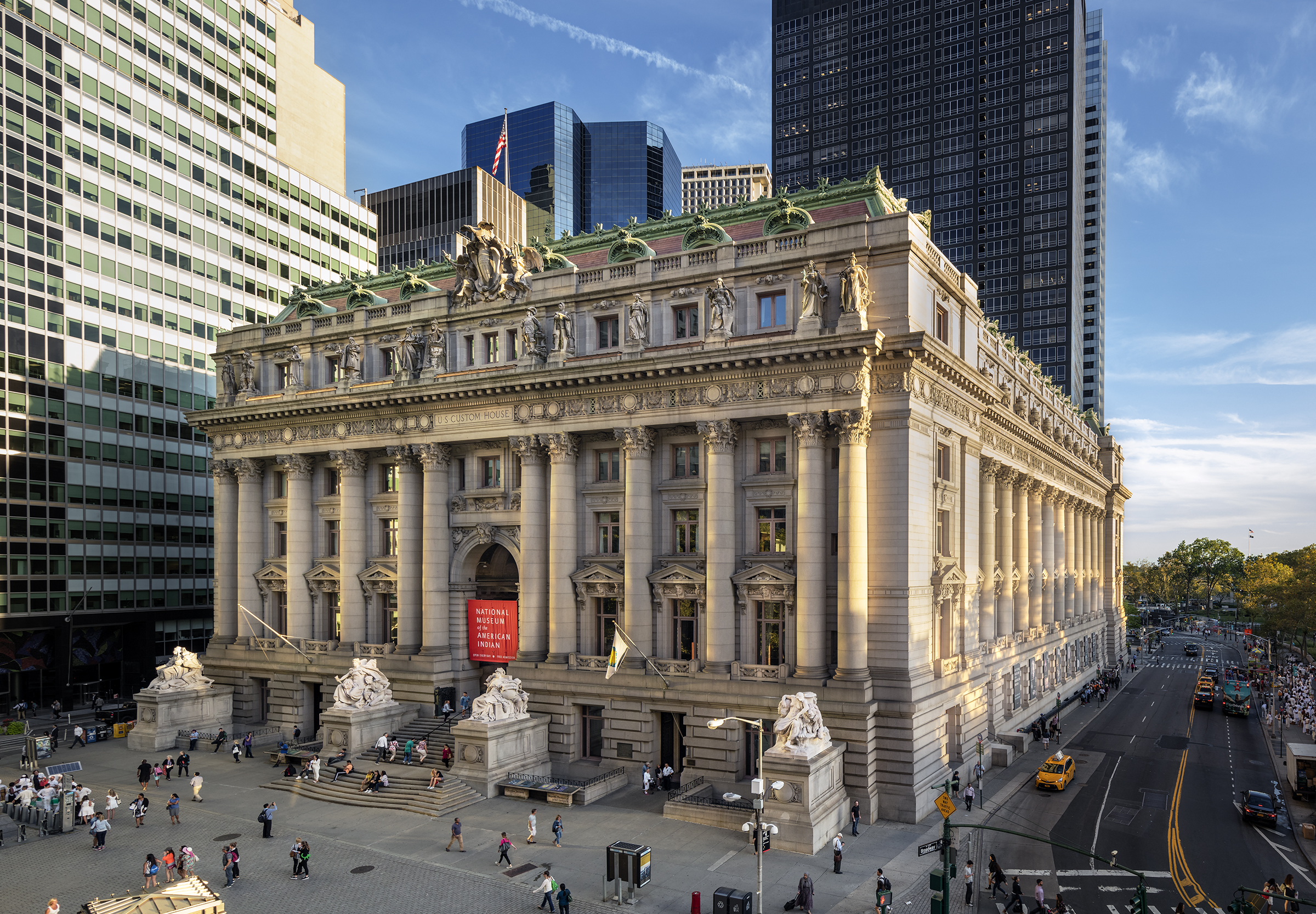National Museum of the American Indian in New York
- Director: Cynthia Chavez Lamar (San Felipe Pueblo)
- Total Full-time Employees (federal and trust): 209 (Washington and New York museums and the Cultural Resources Center)
- Annual Budget (federal and trust) FY22: $52.9 million (Washington and New York museums and the Cultural Resources Center)
- Website: AmericanIndian.si.edu
Background
In partnership with Native peoples and their allies, the Smithsonian’s National Museum of the American Indian fosters a richer shared human experience through a more informed understanding of Native peoples. The National Museum of the American Indian in New York, the George Gustav Heye (pronounced “high”) Center, opened in 1994. It is located in Lower Manhattan in the historic Alexander Hamilton U.S. Custom House, a Beaux-Arts building designed by architect Cass Gilbert and completed in 1907. The museum features year-round exhibitions, dance and music performances, children’s workshops, family and school programs and film screenings that present the diversity of the Indigenous peoples of the Americas and the strength of their cultures from the earliest times to the present.
The museum is part of the Smithsonian’s National Museum of the American Indian, which also includes the Cultural Resources Center and the building on the National Mall in Washington, D.C. The National Museum of the American Indian was established by Congress in 1989. The Heye Center in New York opened in 1994; the Cultural Resources Center, located in Suitland, Maryland, six miles from the National Mall building, opened in 1999; and the National Museum of the American Indian in Washington, D.C., opened in September 2004.
Long-Term and Permanent Collection Exhibitions
"Infinity of Nations: Art and History in the Collections of the National Museum of the American Indian”—a permanent exhibition of about 700 works of Native art from throughout North, Central and South America—demonstrates the breadth of the museum's renowned collection and highlights the historic importance of many of these iconic objects.
“Native New York” opened in fall 2021 and takes visitors on a journey to demonstrate that New York is—and always has been—a Native place. Through first-person accounts, historical narratives and compelling original illustrations, visitors will come to see that the region's story is far more compelling and complex than outdated myths and stereotypes.
“Ancestral Connections,” an exhibition highlighting contemporary art based on traditional crafts, is in the Diker Pavilion for Native Arts and Cultures. The exhibition explores how 10 contemporary artists draw on aspects of their heritage—sometimes combined with personal experiences or tribal history—to create new and compelling works of art. This gallery is closed until further notice.
In addition, the museum hosts a selection of changing exhibitions that present and reaffirm the Native voice. The schedule includes exhibitions developed by the museum from its collections, installations of contemporary Native art and significant traveling exhibitions from other institutions.
Public Programs
The museum hosts Native musicians, dancers, artists and elders in presentations of their art and cultural heritage and in informal programs that invite them to share directly with museum visitors the lifeways and worldviews of Native peoples. Programs include dance presentations, hands-on workshops, storytelling programs and annual events. A schedule of events is available on the museum website.
imagiNATIONS Activity Center
The museum’s learning space, the imagiNATIONS Activity Center, opened in May 2018. The critically acclaimed space is a lively, interactive place where young visitors explore the academic principles behind Native ideas that are so ingenious, they continue to affect modern-day life and scientific disciplines. Visitors leave with a key takeaway—Native people are the original innovators of the Americas.
The imagiNATIONS journey is designed around seven distinct areas of educational focus (Innovation, Nutrition, Medicine, Mathematics, Engineering, Physics and Architecture) and highlights contributions from a multitude of Native nations, cultures and people. The activity center is closed until further notice.
Museum Store and Mili Kàpi Cafe
The Museum Store has long served as New York City’s premier destination to purchase authentic Native American merchandise. Recently expanded, the store now features more items from a wider representation of Native groups than ever before, offering apparel, art, literature, jewelry, food and more for all ages. The site of the Museum Store historically served as the Cashier’s Office of the Alexander Hamilton U.S. Custom House. The renovation of the space preserves original details like antique metal dividers for the cashier’s cages and design flourishes, such as intricate crown molding, grand chandeliers and even the original vault used by the cashiers.
The museum café opened in February 2020 and offers light fare. The café is closed until further notice.
Visiting the Museum
The New York museum is located at One Bowling Green, across from Battery Park. The museum is currently open Monday through Friday from 10 a.m. to 5 p.m. Admission is free. By subway, the museum may be reached by the 1 to South Ferry, the J or Z to Broad Street, the 4 or 5 to Bowling Green or the R or W (on weekdays) to Whitehall Street. More information about visiting is available on the museum’s website. For general information, visitors may call (212) 514-3700. Connect with the museum on Facebook, Twitter, Instagram, YouTube or AmericanIndian.si.edu.
# # #
SI-61-2022
Lisa Austin
212-514-3826


